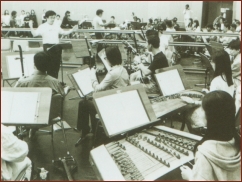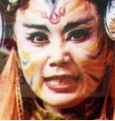 In 1986, the chief of Taipei Chinese Music
Orchestra, Mr. Chen Cheng-shiung invited Mr. Chen Sheng-fu
to produce the libretto Liou Chiuan Presents Melons to give
a large-scaled public performance in the Taipei Arts Festival.
The Ming Hwa Yuan adopted Mr. Chen’s suggestion to use the
method of “fixed music score & fixed tunes” in modern
Chinese Orchestra to fix the tunes of the Ming Hwa Yuan’s
accompaniment. That means to find out the most appropriate
pitch for each Taiwanese Opera performer so that they can
sing with their own tune when performing.
In 1986, the chief of Taipei Chinese Music
Orchestra, Mr. Chen Cheng-shiung invited Mr. Chen Sheng-fu
to produce the libretto Liou Chiuan Presents Melons to give
a large-scaled public performance in the Taipei Arts Festival.
The Ming Hwa Yuan adopted Mr. Chen’s suggestion to use the
method of “fixed music score & fixed tunes” in modern
Chinese Orchestra to fix the tunes of the Ming Hwa Yuan’s
accompaniment. That means to find out the most appropriate
pitch for each Taiwanese Opera performer so that they can
sing with their own tune when performing.
To present better acoustic effects in the theater, the Ming
Hwa Yuan recomposed a brand-new theme song based on the plot,
in order to string up different scenes in the drama and highlight
the theme. In the beginning, Taiwanese Opera performers had
hard time coping with this “fixed music score & fixed
tunes” method, while another problem was that the ensemble
of the percussion instrument and the Chinese Orchestra didn’t
seem to work. However, the affiliation of Chinese music could
efficiently make up for the lack of “dragging singing style”
and atmospheric quality of music in Taiwanese Opera. Besides,
inserting appropriate Chinese music during scene-to-scene
transition could also fill in the gap of what the traditional
accompaniment of Taiwanese Opera couldn’t manage.
Introducing Chinese Orchestra into Taiwanese Opera is quite
a pioneering move. Various kinds of musical instruments, together
with the accompaniment of stringed instruments percussion
instruments, have largely enriched the music capacity of Taiwanese
Opera. Thus, with diversified music types, the Ming Hwa Yuan
could make its performance more appealing to more viewers.
|



